In recent years, functional fitness has become more than just a trend—it's a movement that’s reshaping how Americans approach exercise. Unlike traditional gym routines that isolate specific muscles, functional fitness focuses on exercises that mimic real-life movements, improving strength, balance, flexibility, and coordination in a more practical, everyday sense.
From kettlebell workouts to bodyweight exercises and TRX suspension training, this versatile approach is helping people of all ages build functional strength and prevent injuries.
What Is Functional Fitness?
Functional fitness refers to training your body for real-world activities, like lifting groceries, climbing stairs, or reaching for items on a shelf. These exercises engage multiple muscle groups and emphasize movement patterns such as squatting, pulling, pushing, and rotating.
Key characteristics of functional fitness:
-
Compound movements (multi-joint exercises)
-
Focus on stability, mobility, and balance
-
Improves everyday physical performance
-
Reduces the risk of injury
Why Functional Fitness Is Gaining Popularity
Americans are increasingly turning to functional fitness workouts for their practicality and long-term health benefits. Here’s why it’s become a preferred workout style:
1. Injury Prevention
Functional training strengthens the stabilizing muscles around your joints, reducing the likelihood of common injuries during both workouts and daily life.
2. Enhanced Mobility and Flexibility
By mimicking natural movements, functional workouts improve range of motion and muscle coordination, essential for both young athletes and older adults.
3. Time Efficiency
Functional workouts often involve high-intensity, full-body circuits, allowing you to burn calories, build strength, and improve cardiovascular health all in one session.
Popular Functional Fitness Exercises
You don’t need fancy machines or equipment to get started. Here are some top functional exercises and tools:
-
Kettlebell Swings and Turkish Get-Ups – Great for building explosive strength and core control.
-
Bodyweight Movements – Squats, lunges, planks, and push-ups are highly effective and scalable.
-
TRX Suspension Training – Uses your body weight to improve stability and muscle endurance.
-
Medicine Ball Throws – Ideal for rotational strength and power.
Getting Started with Functional Fitness
Whether you're new to working out or a seasoned athlete, here’s how to integrate functional fitness into your routine:
-
Start with bodyweight exercises to master form and balance.
-
Incorporate functional tools like resistance bands, kettlebells, or a TRX system.
-
Focus on form over speed to prevent injury and maximize gains.
-
Work with a certified trainer if you’re unsure about technique or progression.
Final Thoughts
The rise of functional fitness is a testament to a growing awareness that fitness is not just about aesthetics—it's about living better, moving with ease, and staying strong for life. As more Americans seek smarter, more sustainable ways to stay fit, functional workouts are proving to be one of the most effective and empowering paths forward.
Whether you're looking to improve athletic performance or simply make daily tasks easier, functional fitness might be the workout upgrade you didn’t know you needed.

.jpg)
.jpg)
.jpg)
.jpg)
.jpg)
.jpg)

Social Plugin